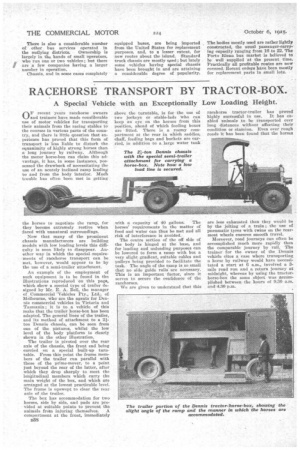RACEHORSE TRANSPORT BY TRACTOR-BOX.
Page 22

If you've noticed an error in this article please click here to report it so we can fix it.
A Special Vehicle with an Exceptionally Low Loading Height.
Oy recent years racehorse owners and trainers have made considerable use of motor vehicles for transporting their animals from the racing stables to the courses in various parts of the country, and there is little question that experience has proved that this form of transport is Tess liable to disturb the equanimity of highly strung horses than a long journey by railway. Although the motor horse-box can claim this advantage, it has, in some instances, possessed the drawback of necessitating the use of an acutely inclined ramp leading to and from the body interior. Much trouble has often been met in getting
the horses to negotiate the ramp, for they become extremely restive when faced with unnatural surroundings.
Now that many of the prominent chassis manufacturers are building models with low loading levels this difficulty is soon likely to disappear. Another way in which the special. require-meats of racehorse transport can be met, however, would appear to be by the use of a semi-trailer attachment.
An example of the employment of such equipment is to be found in the illustraticins reproduced on this page, which show a special type of trailer designed by Mr. E. A. Bell, the manager of Commercial 'Vehicles Pty., Ltd., of Melbourne, who are the agents for Dennis commercial vehicles in Victoria and Tasmania; it is to a vehicle of this make that the trailer horse-box has been adapted. The general lines of the trailer, and its method of attachment to a ton 'Dennis chassis, can be seen from one of the pictures, whilst the low level of the body platform is clearly shown in the other illustration.
The trailer is pivoted over the rear axle of the chassis, the front end being carried on a special built-up turntable. From this point the frame members of the trailer ran parallel with those of the prime-mover, to a point just beyond the rear of the latter, after which they drop sharply to meet the longitudinal members which carry the main weight of the box, and which are arranged at the lowest practicable level. The frame ia upswept to clear the rear axle of the trailer.
The box has accommodation for two horses, side by side, and pads are provided at suitable points to prevent the animals from injuring themselves. A compartment at the front, immediately above the turntable, is for the use of two jockeys or stable-lads who can keep an eye on the horses from this position, ahead of which feeding boxes are fitted. There is a roomy cornnartment at the rear in which saddles, chaff, feeding bags and buckets are carried, in addition to a large water tank with a capacity of 40 gallons. The
horses' requirements in the matter of food and water can thus be, met and all risk of interference is avoided.
The centre section of the off side of the body is hinged at the base, and for loading and unloading purposes can be lowered to form a ramp with but a very slight gradient, suitable cables and pulleys being provided to facilitate the task. The angle of the ramp is so small that no side guide rails are necessary. This is an important factor, since it serves to secure the confidence of the racehorses.
We are given to understand that this
racehorse tractor-trailer has proved highly successful in use. It has enabled animals to be transported over long distances without affecting their condition or stamina. Even over rough roads it has been found that the horses
are less exhausted than they would he by the jolting of a train ; the use of pneumatic tyres with twins on the rearmost wheels ensures smooth travel.
Moreover, road journeys can often be accomplished much more rapidly than the comparable journey by rail. The trainer for the owner of the Dennis vehicle cites a case where transporting a horse by railway would have necessitated a start at 6 a.m., involved a 3mile road run and a return journey at midnight, whereas by using the tractorhorse-box the same object was accomplished between the 'hours of 9.30 am. and 4.30 p.m.
































